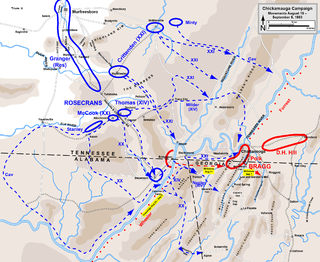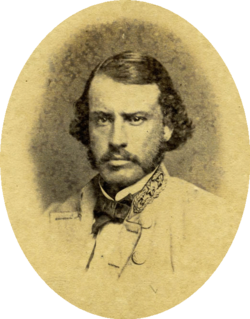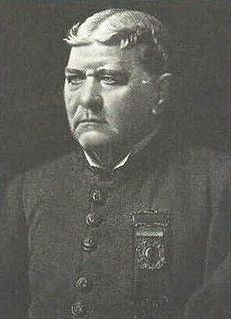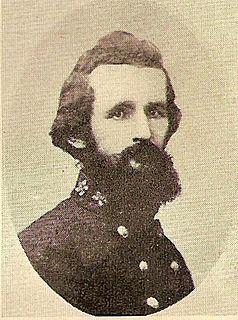
Nathan Bedford Forrest was a Confederate Army general during the American Civil War. Although scholars generally respect Forrest as a military strategist, he has remained a controversial figure in Southern racial history, especially for his role in the massacre of black soldiers at Fort Pillow and his 1867–1869 leadership of the Ku Klux Klan.

Joseph "Fighting Joe" Wheeler was an American military commander and politician. He is known for having served both as a cavalry general in the Confederate States Army in the 1860s during the American Civil War, and then as a general in the United States Army during both the Spanish–American War and Philippine–American War near the turn of the twentieth century. For much of the Civil War he served as the senior cavalry general in the Army of Tennessee and fought in most of its battles in the Western Theater.

The Army of Tennessee was the principal Confederate army operating between the Appalachian Mountains and the Mississippi River during the American Civil War. It was formed in late 1862 and fought until the end of the war in 1865, participating in most of the significant battles in the Western Theater.

The Tullahoma campaign was a military operation conducted from June 24 to July 3, 1863, by the Union Army of the Cumberland under Maj. Gen. William Rosecrans, and regarded as one of the most brilliant maneuvers of the American Civil War. Its effect was to drive the Confederates out of Middle Tennessee and to threaten the strategic city of Chattanooga.
The Battle of Johnsonville was fought November 4–5, 1864, in Benton County, Tennessee and Humphreys County, Tennessee, during the American Civil War. Confederate cavalry commander Major General Nathan Bedford Forrest culminated a 23-day raid through western Tennessee by attacking the Union supply base at Johnsonville. Forrest's attack destroyed numerous boats in the Tennessee River and millions of dollars of supplies, disrupting the logistical operations of Union Major General George H. Thomas in Nashville. As a result, Thomas's army was hampered in its plan to defeat Confederate Lieutenant General John Bell Hood's invasion of Tennessee, the Franklin-Nashville Campaign.

Two corps of the Union Army were called Cavalry Corps during the American Civil War. One served with the Army of the Potomac; the other served in the various armies of the western theater of the war.

The Chickamauga campaign of the American Civil War was a series of battles fought in northwestern Georgia from August 21 to September 20, 1863, between the Union Army of the Cumberland and Confederate Army of Tennessee. The campaign started successfully for Union commander William S. Rosecrans, with the Union army occupying the vital city of Chattanooga and forcing the Confederates to retreat into northern Georgia. But a Confederate attack at the Battle of Chickamauga forced Rosecrans to retreat back into Chattanooga and allowed the Confederates to lay siege to the Union forces.

The 8th Texas Cavalry Regiment, (1861–1865), popularly known as Terry's Texas Rangers, was a regiment of Texas volunteers for the Confederate States Army assembled by Colonel Benjamin Franklin Terry in August 1861. Though lesser known than the Texas Brigade, famous for their actions during the Battle of Gettysburg, the 8th Texas Cavalry distinguished itself at several battles during the American Civil War. In four years of service, Terry's Texas Rangers fought in about 275 engagements in seven states. The regiment earned a reputation that ranked it among the most effective mounted regiments in the Western Theater of the American Civil War.

The Western Theater of the American Civil War encompassed major military operations in the states of Alabama, Georgia, Florida, Mississippi, North Carolina, Kentucky, South Carolina and Tennessee, as well as Louisiana east of the Mississippi River. Operations on the coasts of these states, except for Mobile Bay, are considered part of the Lower Seaboard Theater. Most other operations east of the Mississippi are part of the Eastern Theater. Operations west of the Mississippi River took place in the Trans-Mississippi Theater.

The Battle of Tupelo was a battle of the American Civil War fought from July 14 to 15, 1864, near Tupelo, Mississippi. The Union victory over Confederate forces in northeast Mississippi ensured the safety of Sherman's supply lines during the Atlanta Campaign.

Edward Moody McCook was a lawyer, politician, distinguished Union cavalry general in the American Civil War, American diplomat, and Governor of the Territory of Colorado. He was a member of the famed "Fighting McCook" family of Ohio. Four of his brothers and 10 of his first cousins served as officers, with six of the family members becoming generals before the end of the war.

Francis "Frank" Crawford Armstrong was a United States Army cavalry officer and later a brigadier general in the Confederate States Army during the American Civil War. He is also known for being the only Confederate general to fight on both sides during the Civil War.
The following Confederate States Army units and commanders fought in the Battle of Chickamauga of the American Civil War. The Union order of battle is listed separately. Order of battle compiled from the army organization during the campaign.

Edmund Winchester Rucker was a Confederate officer during the American Civil War. After the war he became an industrial leader of Birmingham, Alabama. Fort Rucker, Alabama was named in his honor.

Fort Wright was constructed in 1861 and located on the second Chickasaw Bluff at Randolph, Tipton County, Tennessee. Fort Wright was a Civil War fortification and the first military training facility of the Confederate Army in Tennessee.

Savas Beatie LLC, commonly referred to as simply Savas Beatie or Savas Beatie Publishing, is a California-based book publishing company established in 2004. To date the company has published more than one hundred and twenty (120) military, general history titles. The company uses the tag line "Independent, scholarly, and a bit old fashioned." Savas Beatie titles are distributed into the general book trade by Philadelphia-based Casemate Publishing. Markets outside the general trade, including individual enthusiasts, national and state historic sites, and specialty sales, are managed inside the company.

Forrest's Cavalry Corps was part of the Confederate States Army during the American Civil War and commanded by Lieutenant General Nathan Bedford Forrest. Formed during the summer of 1862, it took part in the various battles in the Western Theater during the second half of the war. At first serving as part of the Army of Tennessee, both Forrest and the corps were then transferred to northern Mississippi and often launched independent raids into Union occupied western and central Tennessee.

Nathan Bedford Forrest II was an American businessman who served as the 19th Commander-in-Chief of the Sons of Confederate Veterans from 1919 to 1921, and as the Grand Dragon of the Ku Klux Klan for Georgia. Forrest was born in Oxford, Mississippi, in 1871. His grandfather, Nathan Bedford Forrest, was a senior officer of the Confederate States Army who commanded cavalry in the Western Theater of the American Civil War. His only son, Nathan Bedford Forrest III, was a senior officer of the United States Army Air Forces killed in action in the European Theater of World War II.
Moses Wright Hannon was a Confederate States Army colonel during the American Civil War. In August 1864, he was assigned to duty as an acting brigadier general by General John Bell Hood, subject to appointment by Confederate President Jefferson Davis and confirmation by the Confederate Senate. Although Hannon commanded a brigade in the cavalry corps of the Army of Tennessee and in Major General Joseph Wheeler's cavalry corps from June 1864 until the end of the war, he never was officially appointed by Jefferson Davis and confirmed by the Confederate Senate to brigadier general rank.

Charles Constantine Crews was an attorney, physician, railroad executive and Confederate Colonel in the American Civil War. Between 1862-1865, he participated in most of the Western Theater cavalry campaigns of Major General Joseph Wheeler, initially leading the 2nd Georgia Cavalry and eventually a cavalry brigade.

















